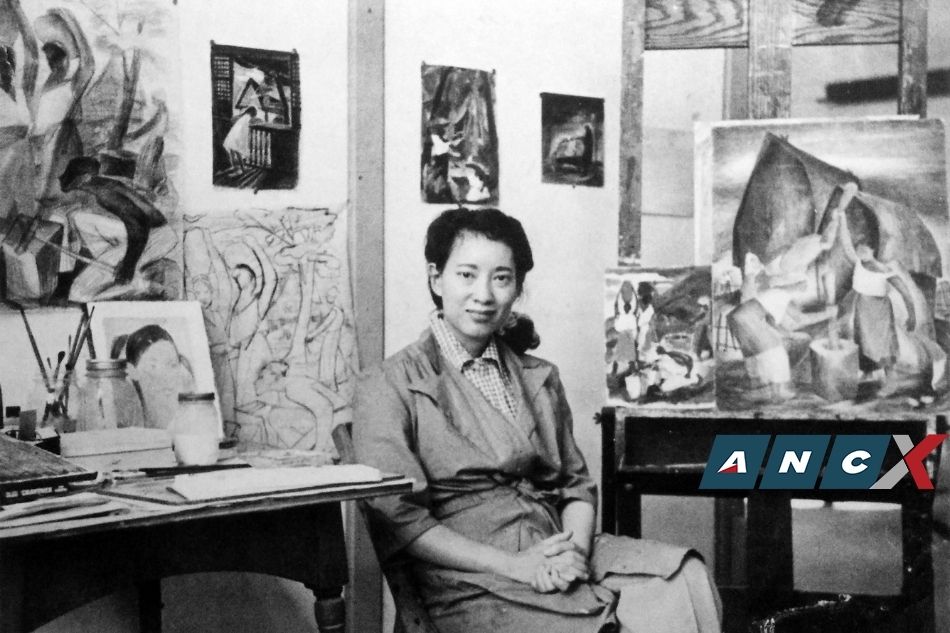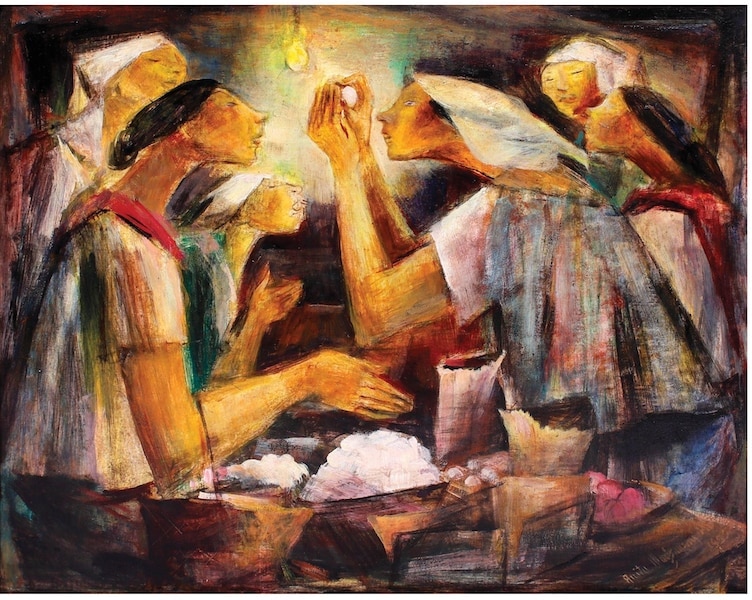Her “Tinapa Vendors” sold for 84 million in February, easily the biggest moneymaker in that major auction which opened the year. Four months later, her “Women with Baskets, Fish and Crab” made P52.6 million at The Spectacular Midyear Auction, outshining a Vicente Manansala as well as a Fernando Amorsolo which, like “Women with Baskets,” depict Filipino market scenes.
As another Anita Magsaysay-Ho painting takes center stage this weekend at Leon Gallery’s Magnificent September Auction, an image called ‘Egg Vendors’ done in the artist’s favored egg tempera medium, with a starting price of P7 million, the question begs to be asked: What is it about this woman’s paintings attract collectors today? Or put another way, how did an artist from the 1950s become the auction sensation of 2021?
For Jaime Ponce de Leon, Director of Leon Gallery, the lady’s achievements, her stature in Manila society and the limited works she left behind are the reasons why an Anita remains highly desirable almost a decade after her passing and more than half a century after the defining years of her career.
“She painted not too many and she painted only for her close circle of friends,” says Ponce de Leon, the force behind the country’s premier auction house. “So her pieces, first and foremost, have cache as her circle belongs to Manila’s highest echelons. The provenances are all pedigreed and that’s already an absolute premium in the parlance of auctions.”
When one thinks of Anita Magsaysay-Ho, one thinks of her bandanna-wearing women in rural settings happily doing everyday things—images inspired by the summer breaks she spent in her native Zambales. She has made iconic images of women making the most ordinary of tasks extraordinary. Her success put her in the limelight and as an equal to the troupe of Neo-Realists and Modernists, almost all male except for Nena Saguil and Lyd Arguilla.
The daughter of an engineer named Ambrosio Magsaysay, brother of the Philippine President Ramon Magsaysay, Anita studied at the UP School of Fine Arts where she was taught by the likes of Fernando Amorsolo and Fabian Dela Rosa, Philippine art stalwarts. Later on, while enrolled at the UP School of Design, Anita would have the privilege of having Victorio Edades as one of her instructors.
Having the means to continue her studies abroad, the young artist left for the US in the 1930s and took courses on oil painting at the Cranbrook Academy in Michigan, and classes in drawing at the Art Student’s League in New York.
She was the first woman to ever win the grand prize in the prestigious Art Association of the Philippines (AAP) competition in 1952. While watching the bidding for her paintings these days has been compared to watching a Wimbledon match with its brisk, nonstop volleys, fighting over the artist’s work isn’t exactly a recent occurrence. Her winning entry in AAP ‘52, "The Cooks," quickly set off a publicized contest to own it as both influential newspaper columnists and rich collectors vied for this treasure, even resorting to attacking each other in the press to gain that privilege.
A few years later, Anita would be even more firmly established. In May 1956, The Sunday Times Magazine — of the most widely read paper in the Philippines with a circulation of 1 Million copies a day —would call her the “the foremost woman painter in the country today” in a feature entitled “Mrs. Ho’s Women.”
Anita’s marketplace paintings by then would be rightly famous. The Sunday Times went on to wax eloquent about the artist, quoting the celebrated American writer, Agnes Newton Keith, in her book “Barefoot in the Palace” on post-war Philippine life, as saying, “(Her) marketplace women are thin, sharp, wiry, loquacious. They are both cunning and generous, both skeptics and believers. (Anita is) sorry for them because she knows she doesn’t have to be. If her gods were wealth and soft living, she’d paint pathos and weakness into those faces. Instead, (she) put mysticism, strength, and love, and joy of life.”
Anita would marry Robert Ho in 1947 and give birth “in quick succession” to five children, one of which would become the society figure and fierce business woman Doris Ho, now President and CEO of the Magsaysay Group of Companies. The Hos “lived in more than 30 homes in more than six countries over a span of 50 years” says a story in Tatler Philippines. They would take up residence in Hong Kong for a time where the couple would host dinners for select friends coming from Manila, as remembered by her longtime chum Charito Panganiban-Melchor and her daughter Doris’s friend, Monique Villonco.
Those who talk about the allure of an Anita painting gush over its aura of serenity, its sense of humor, and the glow that seems to emanate from her women just happily going about the day’s toil. “I think it’s so beautiful because it kind of has a magical feel to it,” says the chef Margarita Forés of ‘Egg Vendors. “I love the warmth of it.”
Having been painted during the country’s post-war years, Anita’s works also embody that timeless spirit of hope, of moving on no matter the odds. And that maybe why her paintings continue to resonate. Has there ever been a time when this country needed hope more?
With the obvious clamor for her works, one must ask the question: are there still Anitas out there awaiting their moment at the auctions? “Certainly,” says Jaime Ponce de Leon. “There are still some in the small circle of friends of Anita. We should be seeing a scant appearance at auction with the dissolution of major estates. But for egg temperas, ‘Egg Vendors’ may be among the last ones to come to market. They are extremely few.”
[Photos courtesy of Leon Gallery]






